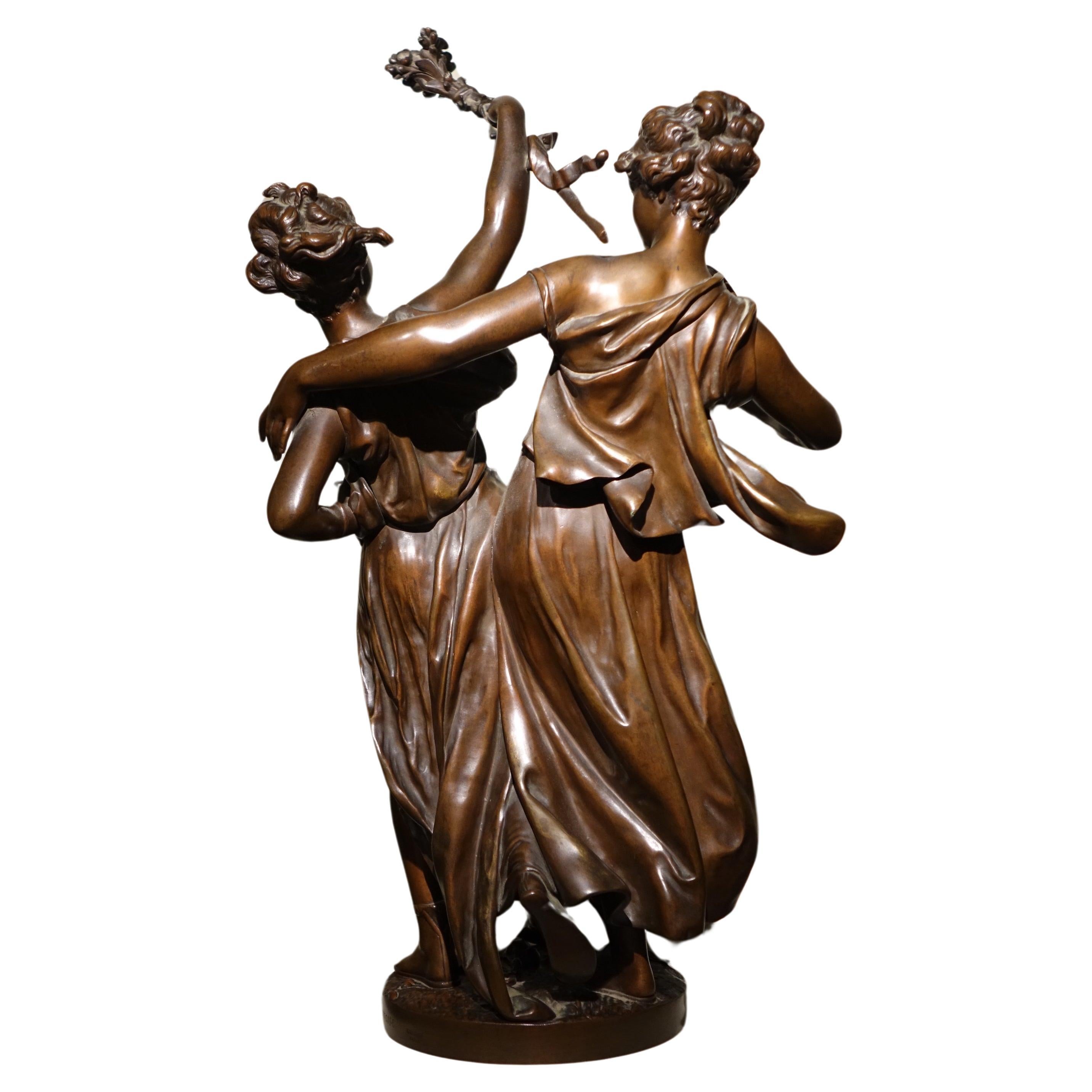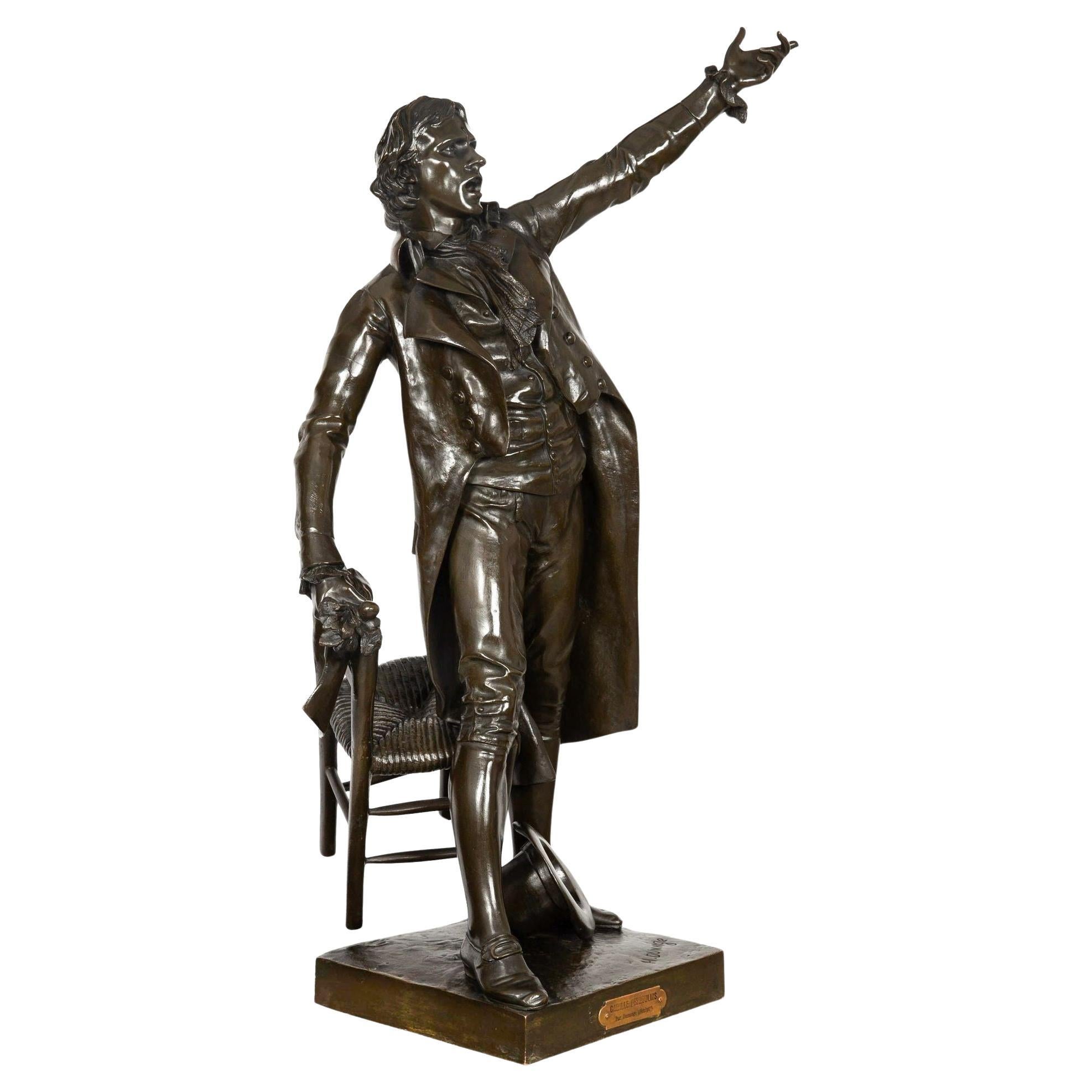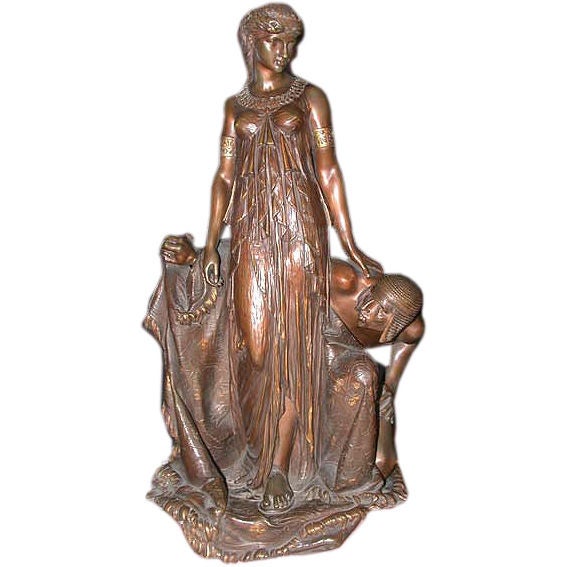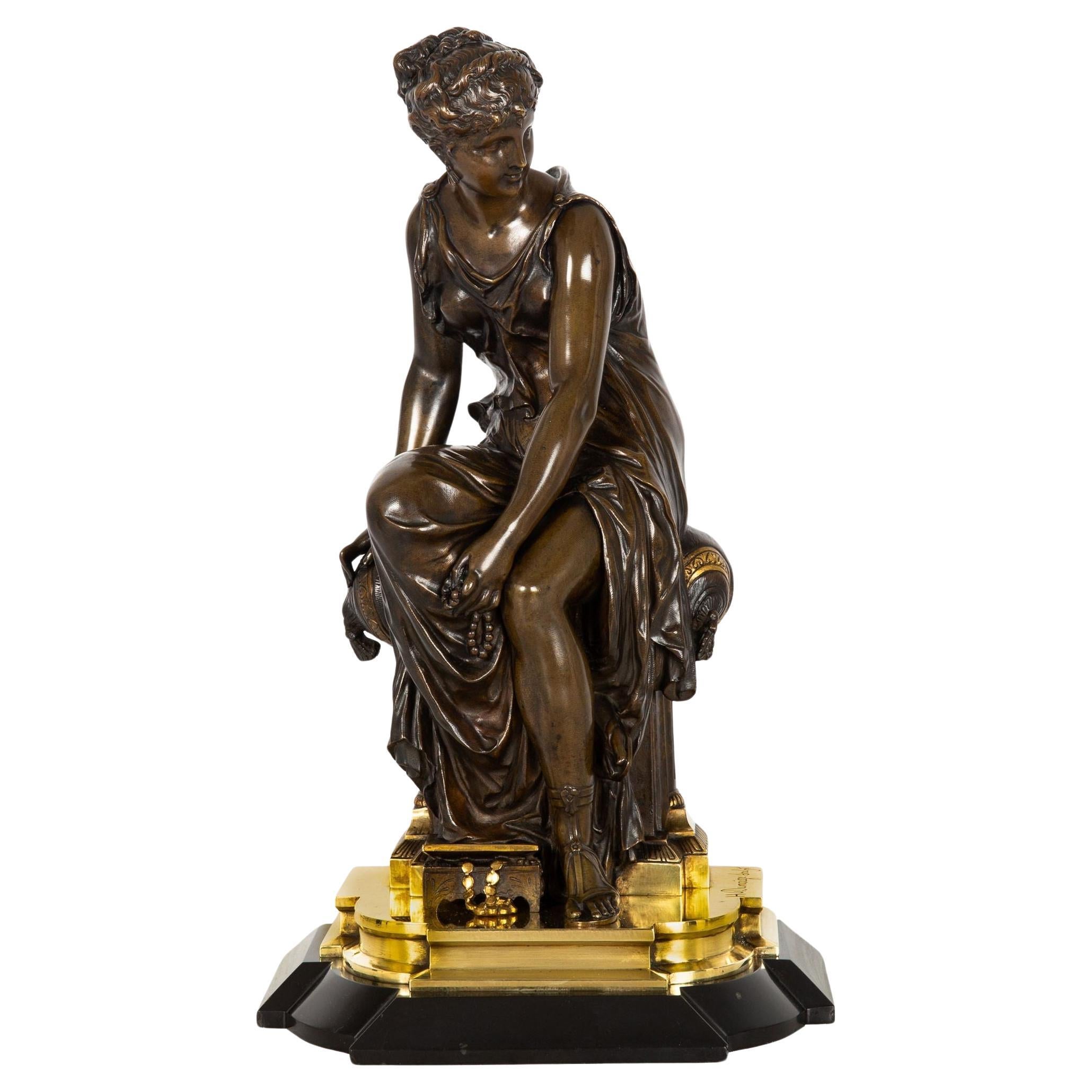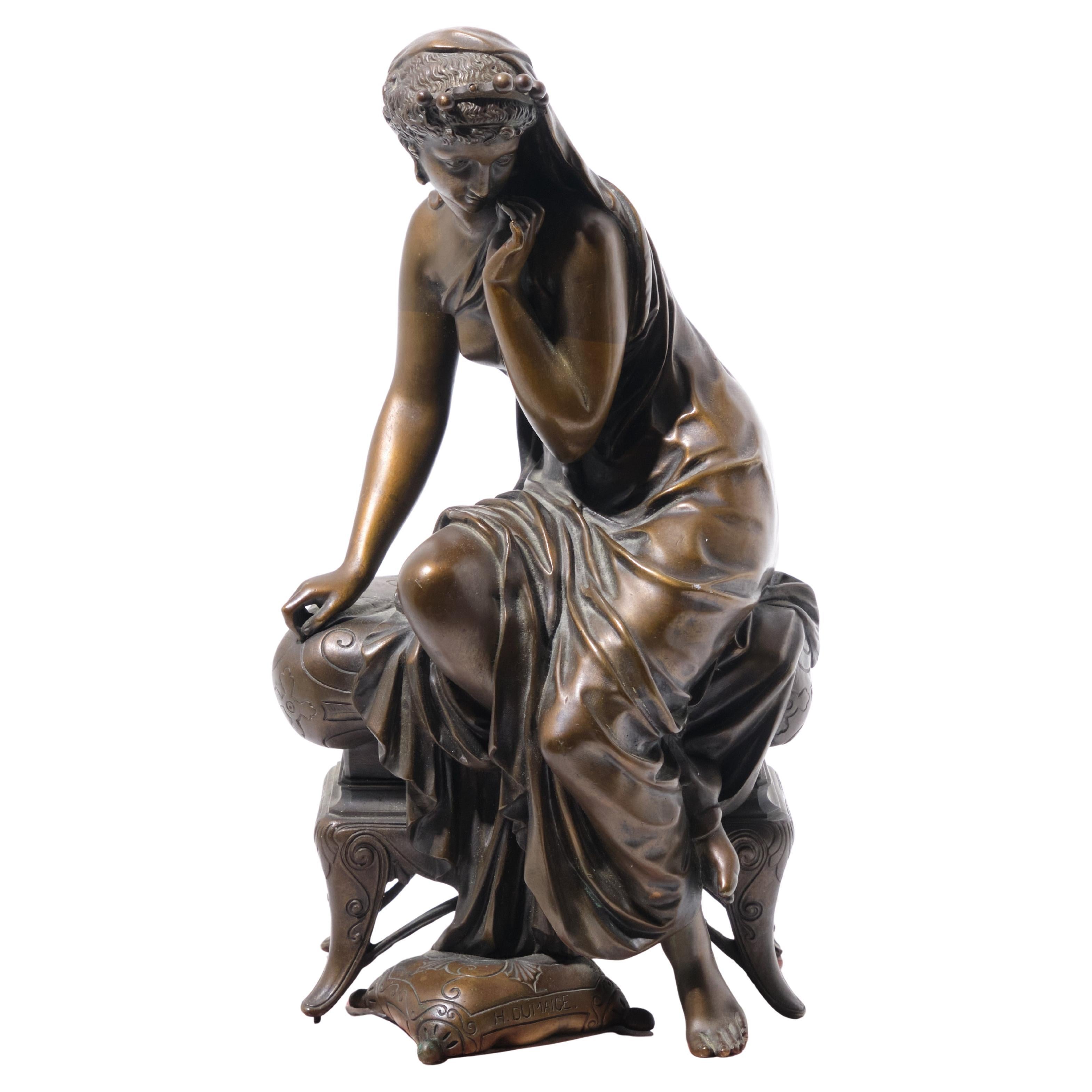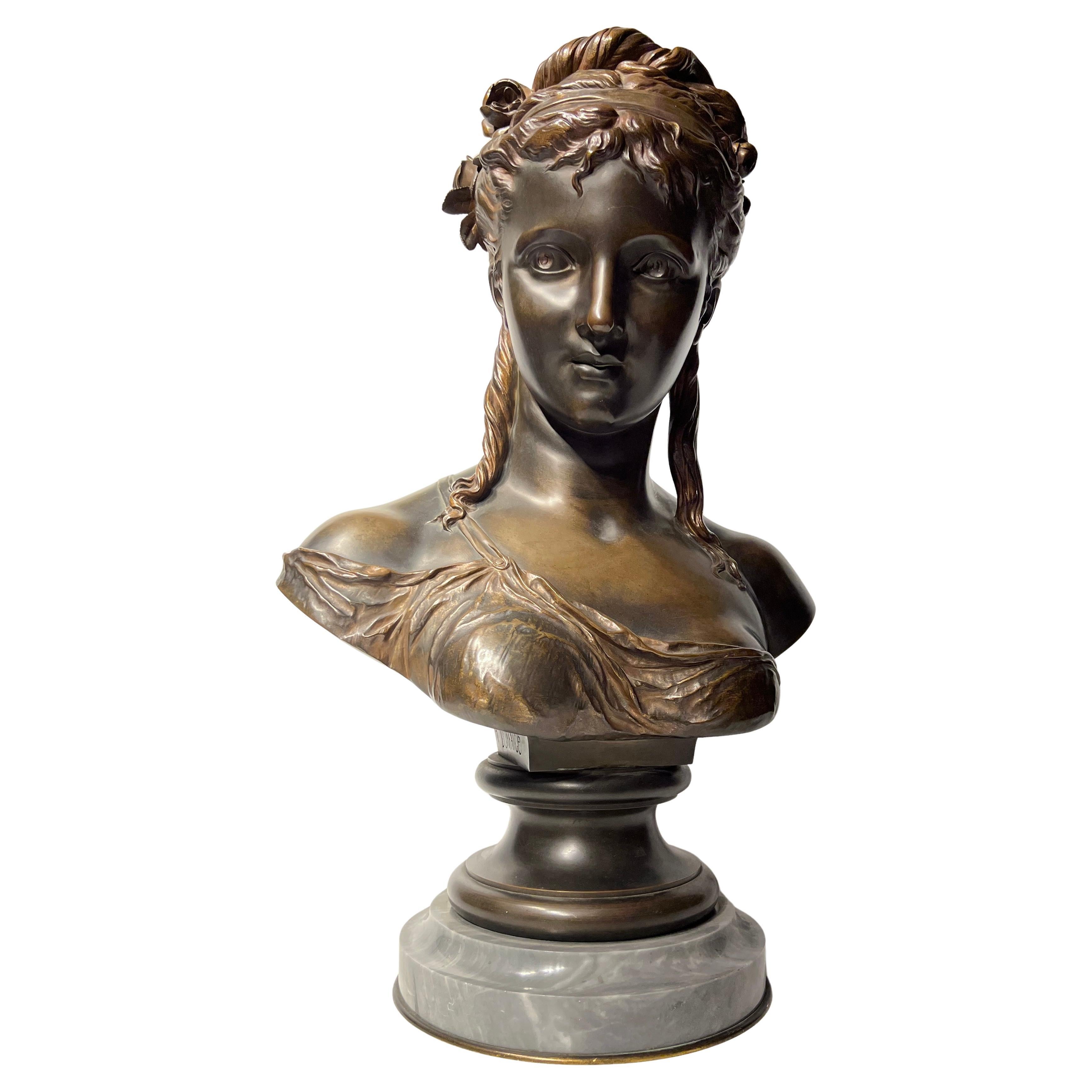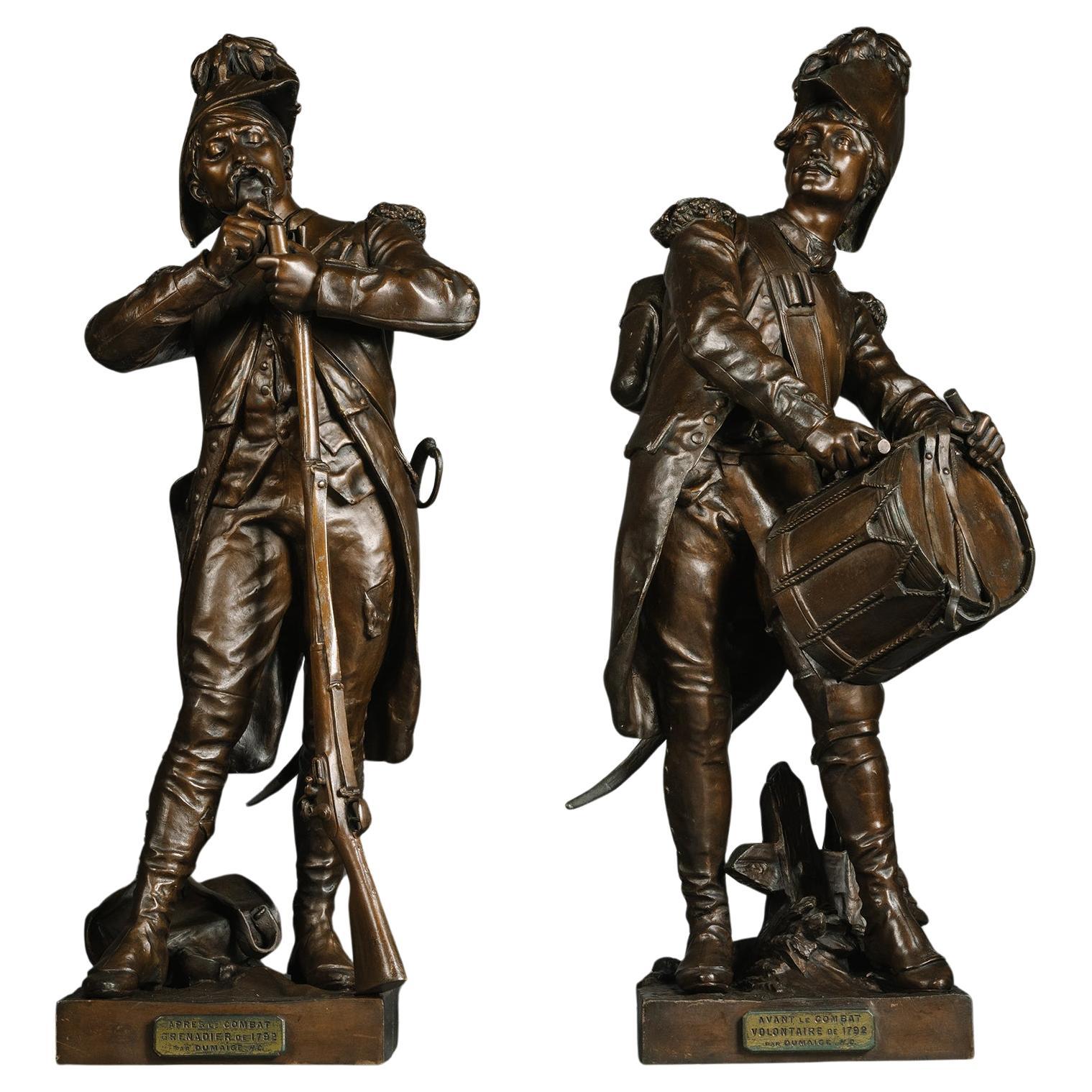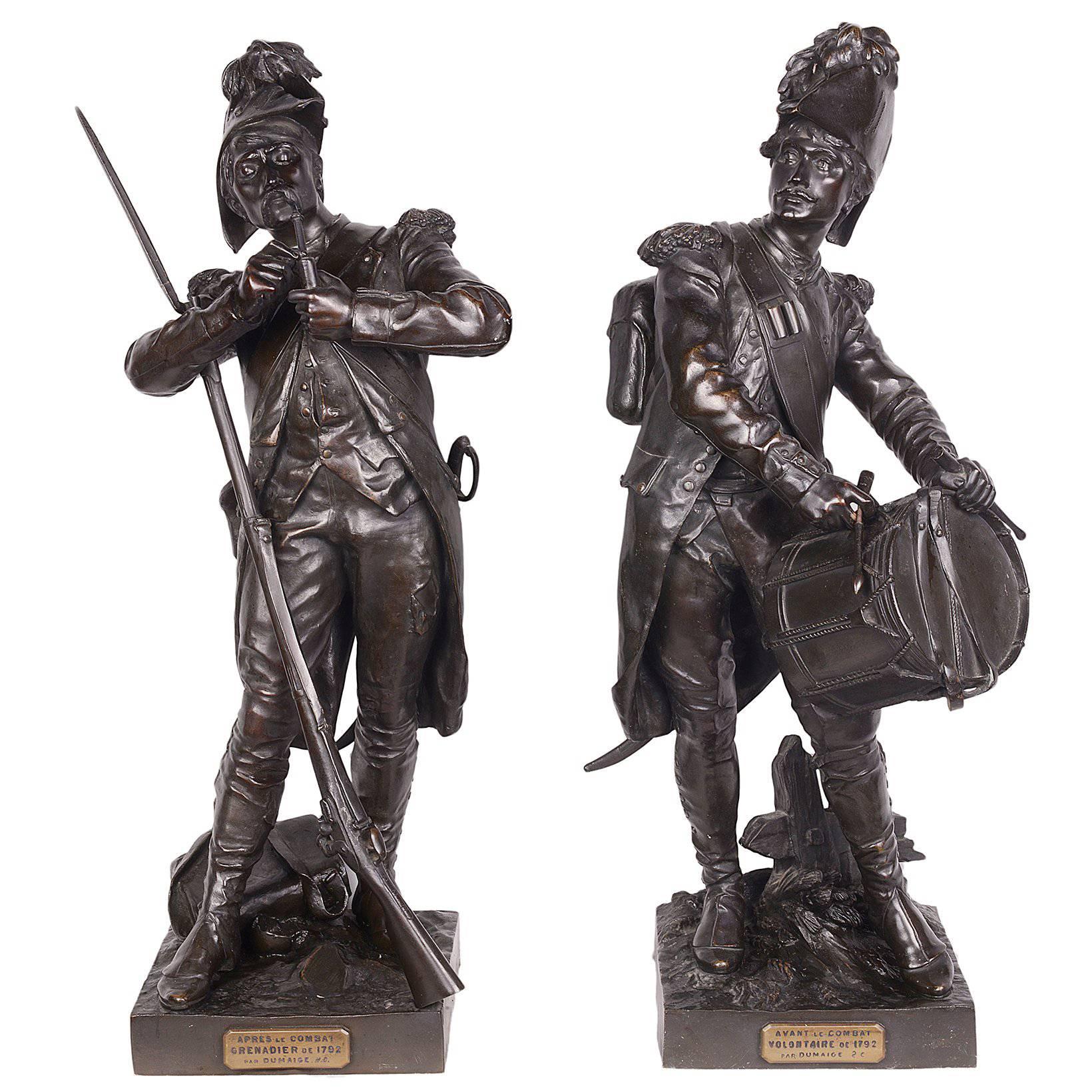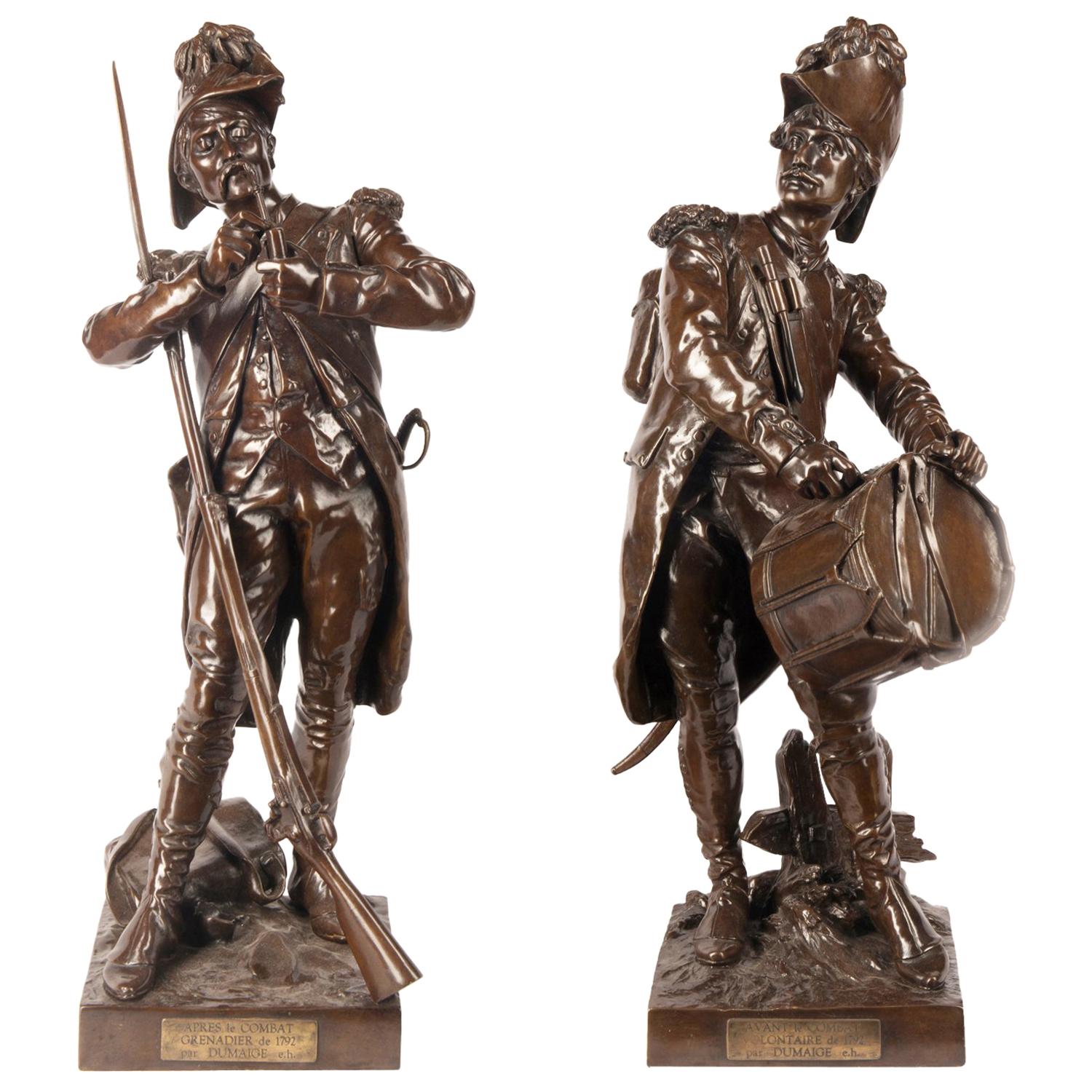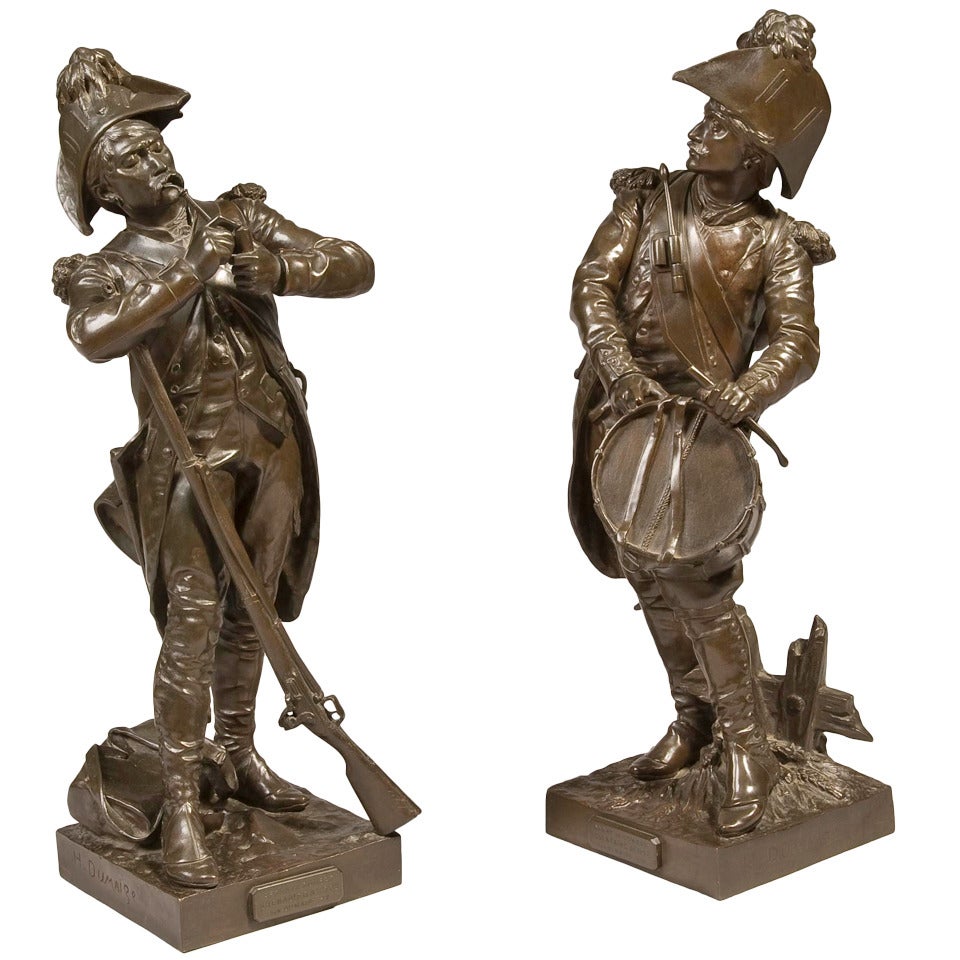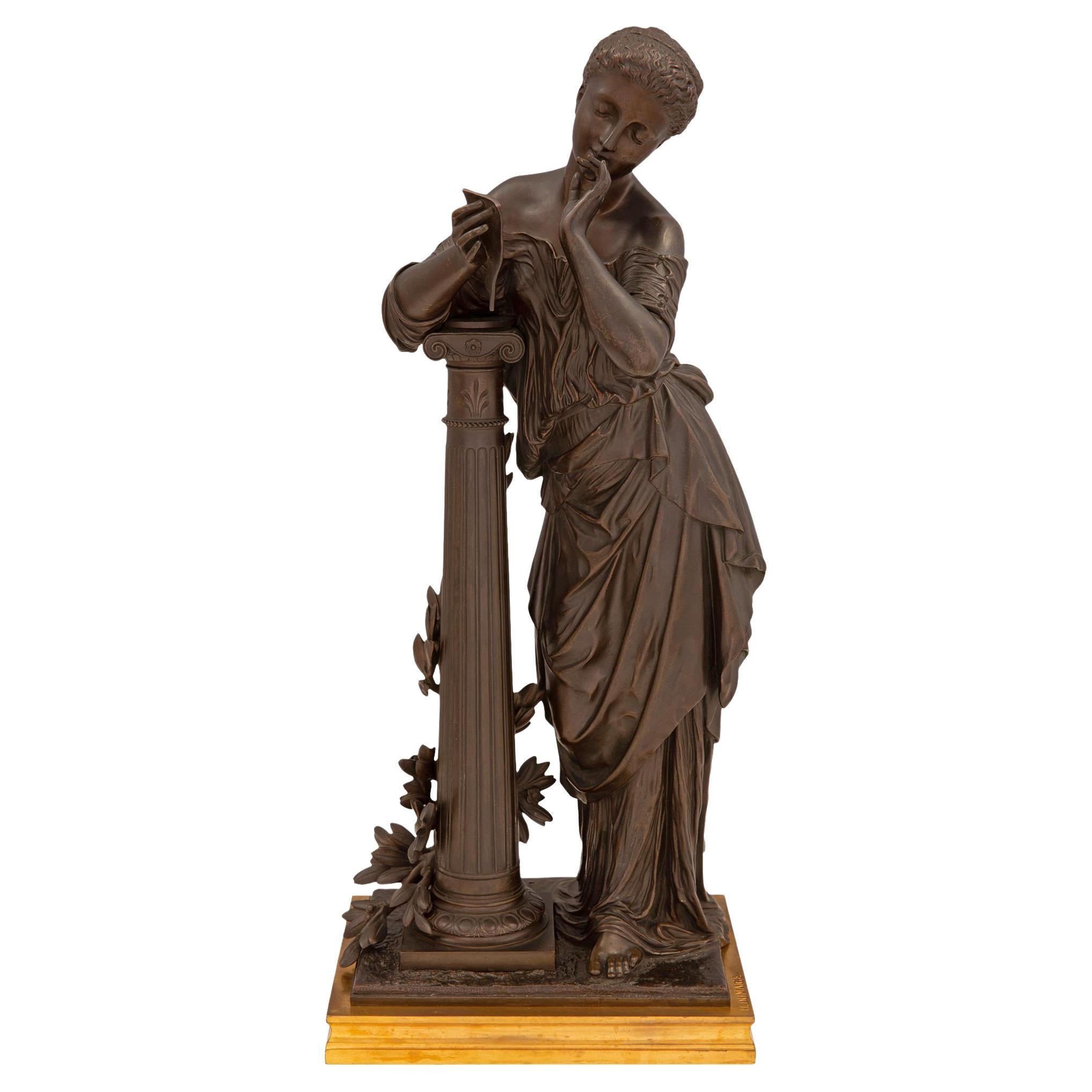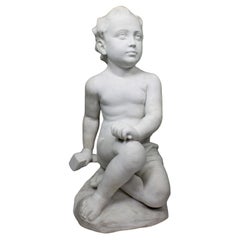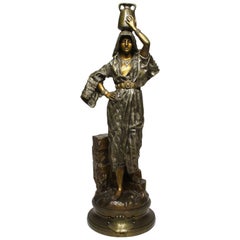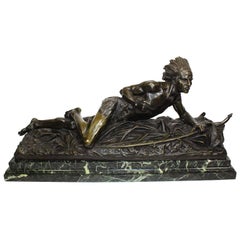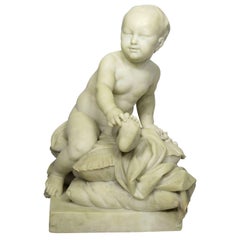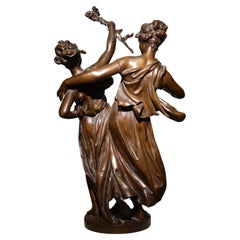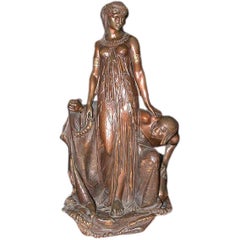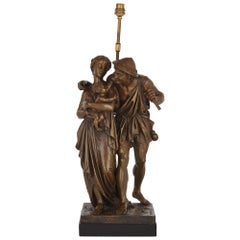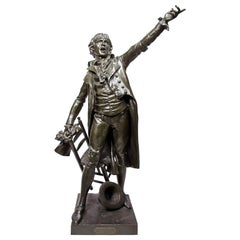
Henry Etienne Dumaige 'French, 1830-1888' Bronze Sculpture of Camille Desmoulins
View Similar Items
Want more images or videos?
Request additional images or videos from the seller
1 of 8
Henry Etienne Dumaige 'French, 1830-1888' Bronze Sculpture of Camille Desmoulins
About the Item
- Creator:Etienne-Henri Dumaige (Sculptor)
- Dimensions:Height: 38 in (96.52 cm)Width: 21.5 in (54.61 cm)Depth: 16.5 in (41.91 cm)
- Style:Rococo (Of the Period)
- Materials and Techniques:Bronze,Cast
- Place of Origin:
- Period:
- Date of Manufacture:circa 1882
- Condition:Wear consistent with age and use. Overall condition is excellent with its original patina. A truly beautiful and dramatic bronze sculpture. Great for a gentleman's study or home office.
- Seller Location:Los Angeles, CA
- Reference Number:Seller: Ref. A17941stDibs: LU179624688023
About the Seller
5.0
Vetted Professional Seller
Every seller passes strict standards for authenticity and reliability
Established in 1982
1stDibs seller since 2016
130 sales on 1stDibs
Authenticity Guarantee
In the unlikely event there’s an issue with an item’s authenticity, contact us within 1 year for a full refund. DetailsMoney-Back Guarantee
If your item is not as described, is damaged in transit, or does not arrive, contact us within 7 days for a full refund. Details24-Hour Cancellation
You have a 24-hour grace period in which to reconsider your purchase, with no questions asked.Vetted Professional Sellers
Our world-class sellers must adhere to strict standards for service and quality, maintaining the integrity of our listings.Price-Match Guarantee
If you find that a seller listed the same item for a lower price elsewhere, we’ll match it.Trusted Global Delivery
Our best-in-class carrier network provides specialized shipping options worldwide, including custom delivery.More From This Seller
View AllFine Marble Sculpture of "The Young Sculptor Boy" - Attr. Adrien Étienne Gaudez
By Adrien Étienne Gaudez
Located in Los Angeles, CA
A Charming French White Marble Sculpture of "A Young Marble Sculptor" depicting a kneeling young boy holding a hammer and a chisel, attributed to Adrien Etienne Gaudez (French, 1845-...
Category
Antique Early 1900s French Neoclassical Revival Figurative Sculptures
Materials
Marble
$8,495 Sale Price
33% Off
After Gaston Leroux French 19th Century Bronze Sculpture of Rebecca
By Gaston Veuvenot Leroux
Located in Los Angeles, CA
A fine French 19th-20th century orientalist silvered and gilt patinated bronze sculpture of "Rebecca" with a plaque that reads "Jeune Fille Arabe" (A Young Arab Girl - Water-Carrier)...
Category
Antique Early 1900s French Greco Roman Figurative Sculptures
Materials
Bronze
$6,985 Sale Price
26% Off
French Bronze Sculpture "Crouching Native American Indian" E. Drouot
By Edouard Drouot
Located in Los Angeles, CA
A very fine French, 19th century Patinated bronze group of a Crouching Native American Indian on the lookout, in a dark brown patina and raised on a veined green marble base, by Edou...
Category
Antique Late 19th Century French Native American Figurative Sculptures
Materials
Marble, Bronze
French 19th Century Carved Marble Sculpture of a Young Boy Prince on a Pillow
By Jean-Baptiste Pigalle
Located in Los Angeles, CA
A very fine and charming French 19th century carved white marble sculpture of a young prince seated on a pillow with tassels. In the manner of Jean-Baptiste Pigalle (French, 1714-178...
Category
Antique 19th Century French Rococo Figurative Sculptures
Materials
Marble
$6,450 Sale Price
46% Off
A French 19th Century Bronze Sculpture Titled "La Sécurité" Eugène Delaplanche
By Eugène Delaplanche
Located in Los Angeles, CA
A very fine French 19th century brown and parcel-gilt patinated bronze sculpture titled "La Sécurité" (The Security - Protection) after a model by Eugène Delaplanche (French, 1836–1891). Depicting a sitting young Maiden in a gilt-decorated armored suit and helmet, a lion skin on her back, holding a resting child on her arm. Raised on Rouge-Royal marble plinth inscribed "La Sécurité - Par E. Delaplanche - Salon des Beaux-Arts de Paris". Signed: E. Delaplanche and stamped with the importer's seal - Alberto Vignes y Ca - Buenos Aires, circa 1890.
Measures: Height: 28 3/4 inches (60.3 cm).
Width: 16 inches (40.7 cm).
Depth: 14 inches (35.6 cm).
Eugène Delaplanche (February 28, 1836 – January 10, 1891) was a French sculptor, born at Belleville (Seine).
He was a pupil of Duret, gained the Prix de Rome in 1864 (spending 1864-67 at the Villa Medici in Rome) and the medal of honor in 1878. His "Messenger of Love" (1874), "Aurora" (1878), and the "Virgin of the Lillies" (1884), are in the Luxembourg. Other works by him are "Music - La Musique" (1878, Paris Opera House), called his masterpiece; "Eve After the Fall" (1869); "Maternal Instruction" (1875, Square of Sainte-Clothilde, Paris). He is also noted for his decorations in relief on vases of Haviland faience. His best work is naturalistic, but at the same time dignified and simple in line and shows sound mastery of technique. He is represented by 15 works in the Glyptothek, Copenhagen and in many other French museums and in churches.
This sculpture of La Sécurité is after his 1884 sculptures...
Category
Antique Late 19th Century French Belle Époque Figurative Sculptures
Materials
Marble, Bronze
$18,450 Sale Price
47% Off
Pair French 19th/20th Century Gilt-Bronze Sculptures of The Marly Horses Lamps
By Guillaume Coustou
Located in Los Angeles, CA
A Fine Pair of French 19th/20th Century Gilt-Bronze Sculptures of "The Marly Horses" (Now turned into lamps) After the original by Guillaume Coustou (French, 1677-1746). The large pair of equestrian bronze sculptures, finished in a gold patina, each depicting rearing horses with their groom, both raised on oval a black slate and Bardiglio marble bases and fitted with modern electrical twin-light brass fittings and cream colored shades. The base on an ebonized wooden platform. Circa: Paris, 1900-1920.
Sculpture & Base Height: 31 1/4 inches (79.8 cm)
Base Width: 21 3/4 inches (55.3 cm)
Base Depth: 12 3/4 inches (32.4 cm)
Height to top of (Adjustable) shade fitting: 48 1/4 inches (122.6 cm)
Shade Height: 15 inches (38.1 cm)
Shade Width: 26 inches (66.1 cm)
Shade Depth: 20 inches (50.8 cm)
The original Marly Horses are two 1743–1745 Carrara marble sculpted groups by Guillaume Coustou. They were commissioned by Louis XV of France for the trough at the entrance to the grounds of his château de Marly. Coustou's last works, they were intended to replace two other sculpted groups, Mercury on Pegasus and Pegasus, Renown of Horses, both by Antoine Coysevox, which had been removed to the Tuileries Gardens in 1719.
Louis XV chose the modellos in 1743 and the full-size sculptures were completed in only two years, being installed at Marly in 1745. They proved highly successful in reproduction, particularly on a smaller scale, and prefigured Théodore Géricault and other Romantic artists' obsession with equestrian subjects. The Marly horses were later also used as the central motif of the monochrome 819-line RTF/ORTF test card which was used on TF1 from 1953 until 1983.
The originals were moved to the place de la Concorde in Paris in 1794 and Louis-Denis Caillouette (1790–1868) restored them in 1840. In 1984 it was concluded that the annual military parades on 14 July were damaging the sculptures and they were replaced by marble copies produced by Michel Bourbon in the studio of a subsidiary of Bouygues. The latter also gained the right to an extra copy, which was placed in Bouygues's social building. The original sculptures were moved to a former courtyard in the Richelieu wing of the Louvre Museum, which was renamed the 'cour Marly' in their honour, whilst Bourbon's two main copies were moved to the originals' first site near the trough at Marly, with work overseen by the architect Serge Macel.
Guillaume Coustou the Elder (29 November 1677, Lyon – 22 February 1746, Paris) was a French sculptor of the Baroque and Louis XIV style. He was a royal sculptor for Louis XIV and Louis XV and became Director of the Royal Academy of Painting and Sculpture in 1735. He is best known for his monumental statues of horses made for the Chateau of Marly, whose replicas now stand in the Place de la Concorde in Paris.
Coustou was a member of a family of famous sculptors; his uncle, Antoine Coysevox, was a royal sculptor; his elder brother, Nicolas Coustou was a sculptor, and his son Guillaume Coustou the Younger also become a noted royal sculptor. Like his older brother, he won the (Prix de Rome) of the Royal Academy which entitled him to study for four years at the French Academy in Rome. However, he refused to accept the discipline of the academy, gave up his studies, set out to make his own career as an artist. He worked for a time in the atelier of the painter Pierre Legros, and eventually returned to Paris.
Upon his return to Paris, he assisted his uncle Coysevox in making two monumental equestrian sculptures, Fame and Mercury, for the Château de Marly, the new residence of Louis XIV near the Palace of Versailles, where he went to escape the crowds and ceremony of the Palace. He later (1740–1745), made his own horses, The Horses of Marly, his most famous works, to replace them. The horses reinvent the theme of the colossal Roman marbles of the Horse Tamers in the Piazza Quirinale, Rome. They were commissioned by Louis XV in 1739 and installed in 1745 at the Abreuvoir ("Horse Trough") at Marly. The horses were considered masterpieces of the grace and expressiveness of the French Late Baroque or Rococo style. After the Revolution they were moved from Marly to the beginning of the Champs-Élysées on the Place de la Concorde. The originals were brought indoors for protection at the Louvre Museum in 1984.
In 1704 Coustou was received into the Académie royale de peinture et de sculpture. The work he made to mark his entrance was Hercules on the Pyre, now in the Louvre. It displays the special hallmark of the Baroque, a twisting and rising transverse pose, as well as highly skillful carving. He rose to become Director of the academy in 1733.
Another of his major works from his later career, the statue of Maria Leszczynska, (1731)is on display at the Louvre.
Coustou also created two colossal monuments, The Ocean and the Mediterranean among other sculptures for the park at Marly; the bronze Rhone, which formed part of the statue of Louis XIV at Lyons, and the sculptures at the entrance of the Hôtel des Invalides. Of these latter, the bas-relief representing Louis XIV mounted and accompanied by Justice and Prudence was destroyed during the Revolution, but was restored in 1815 by Pierre Cartellier from Coustou's model; the bronze figures of Mars and Minerva (1733–34), on either side of the doorway, were not interfered with.
In 1714 for Marly he collaborated in two marble sculptures representing Apollo Chasing Daphne (both at the Louvre), in which Nicolas Coustou sculpted the Apollo and Guillaume the Daphne. About the same time he was commissioned to produce another running figure in marble, a Hippomenes designed to complement an Atalanta copied from the Antique by Pierre Lepautre...
Category
Antique Early 1900s French Louis XV Animal Sculptures
Materials
Marble, Bronze
You May Also Like
Women figures Dancing - Etienne Henry DUMAIGE (1830-1888)
By Etienne-Henri Dumaige
Located in PARIS, FR
Bacchanal, or two young girls dancing and playing the tambourine, one carrying a wand decorated with flowers.
Bronze with Brown patina signed DUMAIGE
Henry Etienne Dumaige...
Category
Antique Late 19th Century Belle Époque Figurative Sculptures
Materials
Bronze
Large 38” French Antique Bronze Sculpture of Camille Desmoulins by Dumaige
By Etienne-Henri Dumaige
Located in Shippensburg, PA
ETIENNE-HENRI DUMAIGE
French, 1830-1888
"Camille Desmoulins at the Palais Royal" (1882)
Sand-cast patinated bronze signed in base "H. DUMAIGE" conceived in 1882, executed circa 1890
stock ref. C104802
38 1/8" H x 11 7/16" D x 11 5/16" W
Essay
Exhibited in plaster at the Salon of 1882 (no. 4331), Dumaige's statue of Camille Desmoulins has become well-regarded as one of his most powerful compositions. The original was given by Dumaige to the Musée de Rouen. It captures Desmoulins delivering his powerful and poignant call to arms before the Bastille storming, the drama of the scene almost operatic as he knocks the chair over behind him, grasping the loose pages of his speech in his closed fist while he loses himself in the rhetoric.
Camille Desmoulins was a French journalist, lawyer, and revolutionary, recognized for his pivotal role in the French Revolution. Born in Guise, France, he studied law at the Collège Louis-le-Grand in Paris, where he befriended future revolutionary leaders, including Maximilien Robespierre. Desmoulins gained prominence on July 12, 1789, when his impassioned speech at the Palais-Royal incited the storming of the Bastille two days later, marking a critical moment in the Revolution.
As a journalist, Desmoulins founded and edited Les Révolutions de France et de Brabant, a radical publication that criticized the monarchy and aristocracy. His writing was instrumental in shaping revolutionary sentiment, blending incisive political critique with populist rhetoric. Despite his early radicalism, Desmoulins later advocated for moderation during the Reign of Terror, aligning himself with the Dantonist faction. This shift ultimately led to his downfall.
Arrested alongside Georges Danton...
Category
Antique 19th Century French Romantic Figurative Sculptures
Materials
Bronze
Henri Etienne Dumaige 1830-1888 Cleopatra before Caesar, bronze
By Etienne-Henri Dumaige
Located in Montreal, QC
Henri Etienne Dumaige 1830-1888 Cleopatra before Caesar, bronze
This Orientalist group alludes to the spectacular meeting of Caesar and Cleopatra...
Category
Antique 19th Century French Egyptian Revival Sculptures
Materials
Marble, Bronze
Bronze Sculptural Lamp by Henry Étienne Dumaige
By Etienne-Henri Dumaige
Located in London, GB
Bronze sculptural lamp by Henry Étienne Dumaige
French, 19th century
Measures: Height 69cm, width 28cm, depth 23cm
This fine figurative lamp is by Étienne Henry...
Category
Antique 19th Century French Figurative Sculptures
Materials
Bronze
French Bronze Sculpture Seated Woman by Etienne-Henri Dumaige
By Etienne-Henri Dumaige
Located in Shippensburg, PA
ETIENNE-HENRI DUMAIGE
French, 1830-1888
Classical Seated Woman with Treasure Spilling at Her Feet
Burnished and patinated bronze over original polished black marble base signed in cast "H. Dumaige Sculpt" and cold-stamped 3750 circa 1875
Item # 309OXB09P
This exquisite cast depicts a full-length seated female modeled with echoes of classical antiquity. Dumaige seeks to depict the young woman as a noble likely of the Roman Empire, her wealth an obscene display with pearls falling from her fingers almost as an afterthought over a chest of jewels with treasure spilling from the lid before her overstuffed throne with a richly decorated pillow...
Category
Antique 19th Century French Romantic Figurative Sculptures
Materials
Marble, Bronze
$3,080 Sale Price
20% Off
Etienne Henri Dumaige Signed French Classical Renaissance Style Bronze Sculpture
By Etienne-Henri Dumaige
Located in Kingston, NY
Etienne Henri Dumaige created this patinated bronze sculpture depicting a seated woman in the 19th century. The artwork is signed on the cushion.
Measurement: With Base: 13 x 6 3/4...
Category
Antique 19th Century French Figurative Sculptures
Materials
Bronze
Recently Viewed
View AllMore Ways To Browse
Orange Glass Lamp
Square Porcelain
Tall Midcentury Table Lamps
Black And Brass Chair
French Georgian
New York 1939 Worlds Fair Chair
Red And Yellow Persian
Straight Chair
Antique Oak Side By Side
Dining Table Legs Leaves
Italian Hall Rack
Rounded Square Dining
Small Vintage Lamp
26h Dining Table
Antique Oak Table Legs
French Botanical
French Wood Carving
Glass Trolleys
